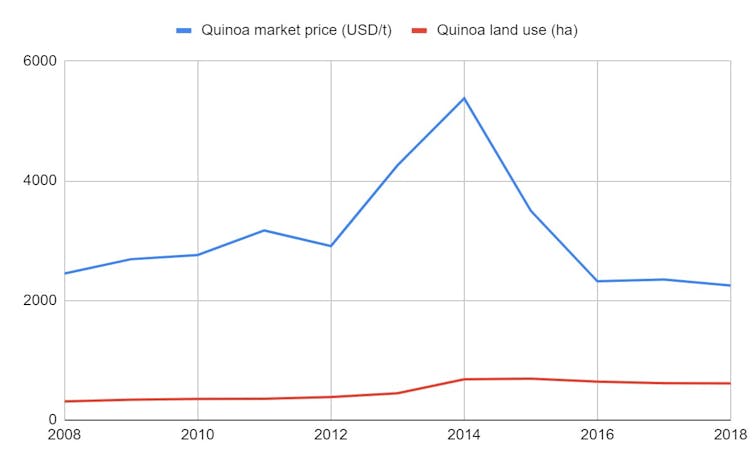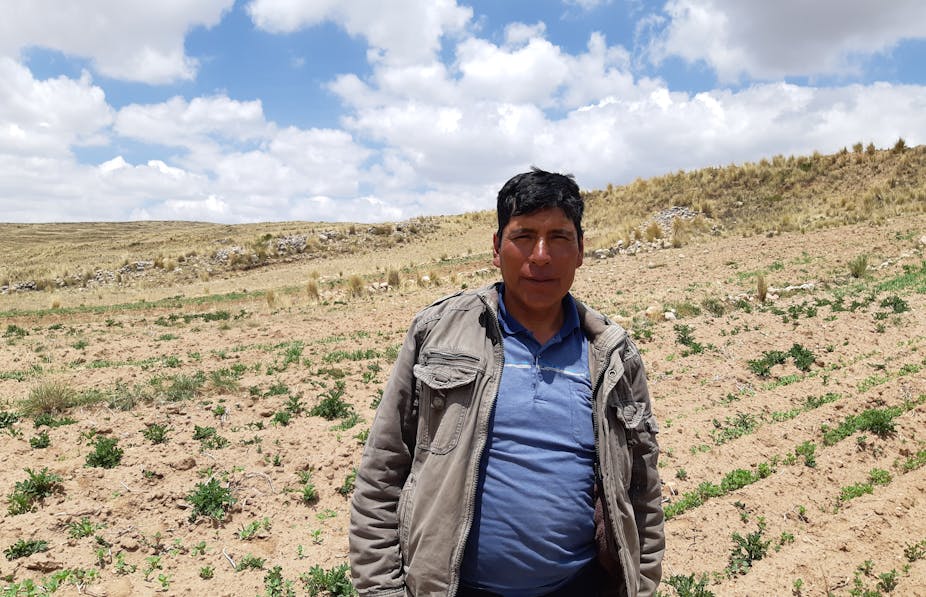It’s been 7,000 years since indigenous rural communities of the Andes first grew quinoa. Among these deserted highlands, recognised by the United Nations as “globally important ingenious agricultural heritage systems” (GIAHS), farmers have always faced drought, frost and the difficulties of intense solar radiation. In the context of the ongoing climate and pandemic crises, traditional crops such as quinoa now have an even more fundamental role to play in preserving the local biodiversity heritage.
Economic miracle or mirage?
Over the last 40 years, Peru has experienced a quinoa boom, marked by the announcement of the “International Year of Quinoa” in 2013 by the UN’s Food and Agriculture Organization. Its perceived qualities as a “superfood” (rich in compounds considered beneficial to a person’s health) led it to cross the oceans and land on European and North American tables, swelling demand for a product of which Peru is the world’s leading producer.
As result, the price of quinoa rose from 3 dollars per kilogram in 2012 to more 5 dollars in 2014. Between 2012 and 2014 the land dedicated to quinoa cultivation in Peru nearly doubled, rising from 35,000 hectares to more than 65,000. In 2014, however, the price collapsed, returning to 2012 levels. Quinoa is still an important commodity in Peru for both the local and global market, helping farmers to diversify their income and have a side role in household consumption. Peru leads the quinoa export from the Andean country accounting for 60% of the global trade in 2018 (Figure 1).

The quinoa boom profoundly changed the country’s agricultural system, giving rise to large producers in lower elevation areas and on the coast. There, agriculture is mechanised, practices are more intensive, the use of pesticides and chemical fertilisers is more widespread and the supply of cheap labour is more abundant.
To cash in on the global boom, other countries are now trying to grow their own quinoa – even China is working to become a player, with agricultural policies that in recent years have encouraged the cultivation of more nutritional and diversified foods such as quinoa. The new producers of quinoa creating a fierce competition against which Peru’s small-scale farmers struggle.
Traditional varieties on the decline
Before the quinoa boom, black and yellow quinoa were also produced in the Andes, but these traditional varieties have small grains. The global demand for large grains and white quinoa brought them to the forefront, and many farmers abandoned traditional varieties. In Peru’s Puno region, one of the centres of quinoa production in the Andes, farmers today tend to prefer improved varieties over traditional ones.
In addition to having larger, white grains that are popular with consumers, newer varieties resist mildew, mature faster and have lower levels of saponin. Farmers who prefer traditional varieties tend to have smaller farms. Rather than focusing on large-scale production and export, their primary concern is often their own food security, a crucial problem during the pandemic crisis.
Food security in time of crisis
As the Covid-19 pandemic unfolded, many of the students and young workers living in Lima who were originally from the Puno Region returned to their home villages. Here they rejoined their families and helped them with the farming activities, mainly quinoa harvesting. After March 15, Peru’s nationwide lockdown prevented farmers from travelling to towns, making it impossible for them to sell their production. Some abandoned the large-scale harvests and produced only what was necessary for the family to be self-sufficient. The distance from markets featuring foods promoted by globalisation – pasta and rice – brought back an interest in local recipes with potatoes and traditional varieties of quinoa.
For the farmer Wuilber Machaca, who lives with his family in the Aymara community of Huancarani in the Puno region, quinoa represents a beacon of hope. At the International Quinoa Research Symposium organized by Washington State University’s Sustainable Seed Systems Lab and Food Systems Program, held August 17-19 in Seattle. “Global demand made us abandon many native varieties”, Machaca said. The potential of selling internationally pushed farmers toward variants that were more productive and pleasing to consumers, but that required intensive farming. Today, however, the ability of traditional varieties to grow in scarce water conditions enables them to better withstand climate change. This advantage provides small farmers with food security and also respect the role of the community in maintaining traditional varieties.
This article was co-written by Lorenzo Pirovano, a freelance data and investigative journalist.

